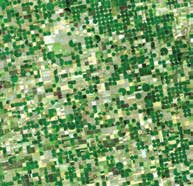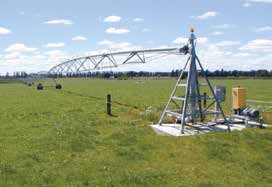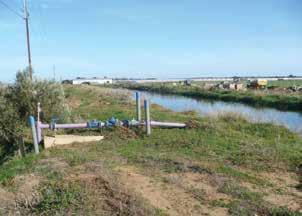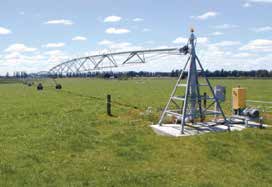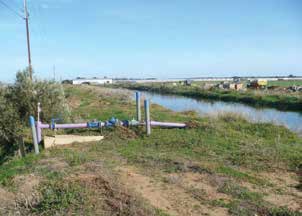Chapter 17
Managing Water:
irrigation and drainage
Worldwide, over two billion acres of virgin land have been plowed and brought into agricultural use since 1860. Until the last decades of the twentieth century, clearing new land compensated for loss of agricultural land. In the 1980s the total amount of land under cultivation began declining for the first time since farming reached the land between the Tigris and the Euphrates.
—david MontgoMery, 2007
Deficits and excesses of water are the most significant
failures were also responsible for the collapse of soci-
yield-limiting factors to crop production worldwide. It is
eties. Notably, the salinization of irrigated lands in
estimated that more than half of the global food supply
Mesopotamia and filling up of ditches with sediments—
depends on some type of water management. In fact, the
cleaned out by enslaved Israelites among others—resulted
first major civilizations and population centers emerged
in lost land fertility and an inability to sustain large
when farmers started to control water, resulting in more
centrally governed civilizations.
consistent yields and stable food supplies. Examples
Today, many of the most productive agricultural
include Mesopotamia—literally the “land between the riv-
areas depend on some type of water management. In
ers” (the Tigris and Euphrates), the lower Nile Valley, and
the United States, average crop yields of irrigated farms
China. High yields in drained and irrigated areas allowed
are greater than the corresponding yields of dryland
for the development of trade specialization, because no
farms by 118% for wheat and 30% for corn. At a global
longer did everyone need to provide their own food
scale, irrigation is used on 18% of the cultivated areas,
supply. This led to important innovations like markets,
but those lands account for 40% of the world’s food
writing, and the wheel. Moreover, new water manage-
production. The great majority of agricultural lands
ment schemes forced societies to get organized, work
in the western U.S. and other dry climates around
together on irrigation and drainage schemes, and develop
the world would not be productive without irrigation
laws on water allocations. But water management
water, and the majority of the U.S. horticultural crop
Photo by Judy Brossy
187
Building SoilS for Better CropS: SuStainaBle Soil ManageMent
chAPter 17 Managing Water: irrigation and drainage
Table 17.1
fields earlier in the spring and harvest later in the fall
Approximate Amounts of Water Needed for Food Production
without causing extreme compaction.
Product
Gal ons of Water per Pound
The benefits of irrigation and drainage are thus
Wheat
150
obvious. They are critical to food security as well as to
Rice
300
the agricultural intensification needed to protect natural
Corn
50
areas. Concerns with climate change, which is result-
Potatoes
19
ing in greater occurrences of deficits and excesses of
Soybeans
275
precipitation, will increase pressure for more irrigation
Beef
1,800
and drainage. But they also exact a price on the environ-
Pork
700
ment. Drainage systems provide hydrological shortcuts
Poultry
300
and are responsible for increased chemical losses to
Eggs
550
water resources. Some irrigation systems have resulted
Milk
100
in drastic changes in river and estuarine ecosystems,
Cheese
600
as well as land degradation through salinization and
sodium buildup, and have been sources of international
Source: FAO.
conflict. In the case of the Aral Sea—formerly the fourth
acreage—especially in California—is entirely dependent
largest inland freshwater body in the world—the diver-
on elaborate irrigation infrastructures. Even in humid
sion of rivers to use for irrigated cotton farming in the
regions most high-value crops are grown with irrigation
former USSR resulted in a 50% decrease in the area
during dry spells to insure crop quality and steady sup-
of the sea. It also became severely contaminated with
plies for market outlets, in part because the soils have
drainage water from agricultural fields.
become less drought resistant from intensive use.
To address excess water problems, the best fields in
IRRIgATION
the U.S. corn belt have had drainage systems installed,
There are several different types of irrigation systems,
which made those soils even more productive than they
depending on water source, size of the system, and
were naturally. Drainage of wet fields allows for a longer
water application method. Three main water sources
growing season because farmers can get onto those
exist: surface water, groundwater, and recycled
fIrst consIder soIL IMProveMent
Healthy soils with good and stable aggregation, enhanced organic matter levels, and limited or no compaction go a long way toward “drought proofing” your farm. In addition, reduced tillage with residues on the surface also helps to enhance water infiltration and reduce evaporation losses from the soil. Cover crops, while using water for their growth, can act as a water-conserving surface mulch once they are suppressed. But, of course, water is needed to grow crops—from 19 gal ons to hundreds or more gal ons of water for each pound of plant or animal product (table 17.1). And if it doesn’t rain for a few weeks, crops on even the best soils will start to show drought stress. Even in humid regions there can be stretches of dry weather that cause stress and reduce crop yield or quality. Irrigation, therefore, is an essential part of growing crops in many regions of the world. But the healthier the soil you have, the less irrigation water that will be needed because natural rainfall will be used more efficiently.
188
Building SoilS for Better CropS: SuStainaBle Soil ManageMent
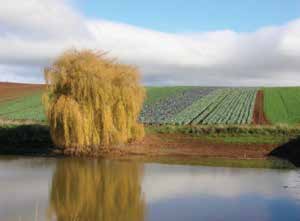
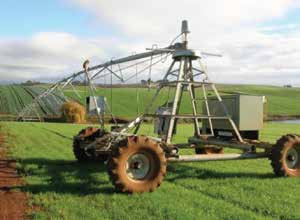
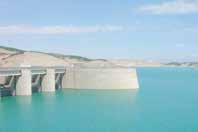
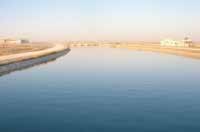
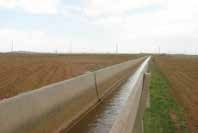
chAPter 17 Managing Water: irrigation and drainage
Figure 17.1. A farm pond (left) is used as a water source for a traveling overhead sprinkler system (right) on a vegetable farm.
wastewater. Irrigation systems run from small on-farm
Small-scale irrigation systems nowadays tend
arrangements—using a local water supply—to vast
to pump water directly out of streams or farm ponds
regional schemes that involve thousands of farms and
(figure 17.1). These water sources are generally sufficient
are controlled by governmental authorities. Water appli-
for cases in which supplemental irrigation is used—in
cation methods include conventional flood, or furrow,
humid regions where rainfall and snowmelt supply most
irrigation—which depends on gravity flow—and pumped
of the crop water needs but limited amounts of addi-
water for sprinkler and drip irrigation systems.
tional water may be needed for good yields or high-qual-
ity crops. Such systems, generally managed by a single
Surface Water Sources
farm, have limited environmental impacts. Most states
Streams, rivers, and lakes have traditionally been the
require permits for such water diversions to ensure
main source of irrigation supplies. Historical efforts
against excessive impacts on local water resources.
involved the diversion of river waters and then the
Large-scale irrigation schemes have been
development of storage ponds. Small-scale systems—like
developed around the world with strong involvement
those used by the Anazasi in the southwestern U.S. and
of state and federal governments. The U.S. government
the Nabateans in what is now Jordan—involved cisterns
invested $3 billion to create the intricate Central Valley
that were filled by small stream diversions.
project in California that has provided a hundredfold
Figure 17.2. The Ataturk Dam, part of the GAP project in Turkey, diverts water from the Euphrates River (left). The main canal (middle) conveys water to the Harran Plain for distribution to individual fields (right).
189
Building SoilS for Better CropS: SuStainaBle Soil ManageMent
